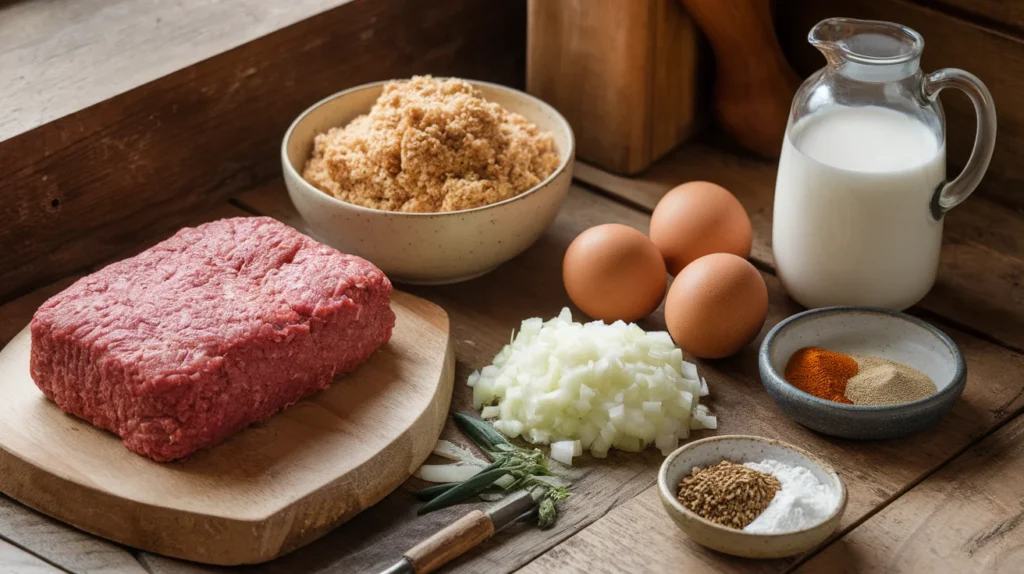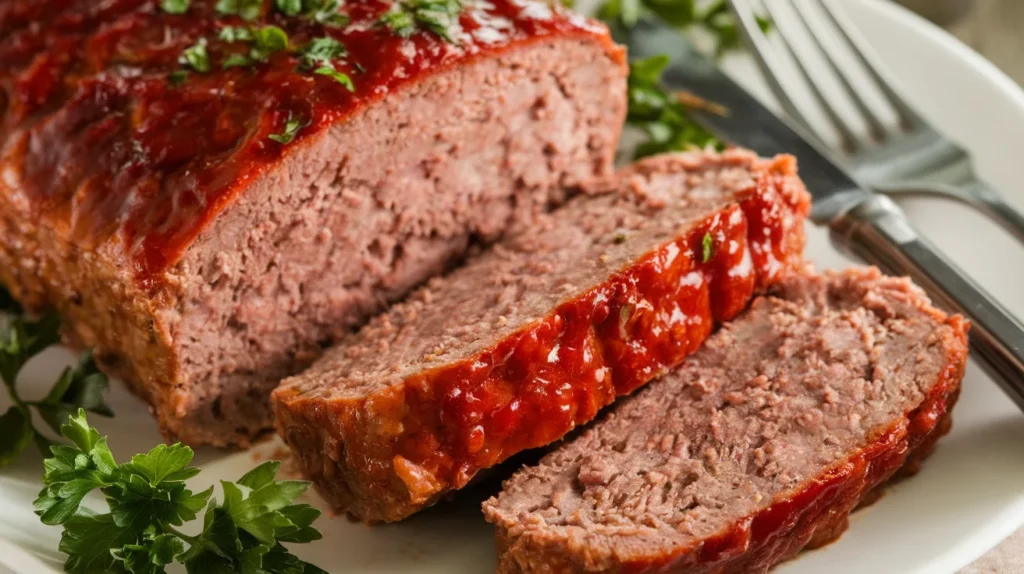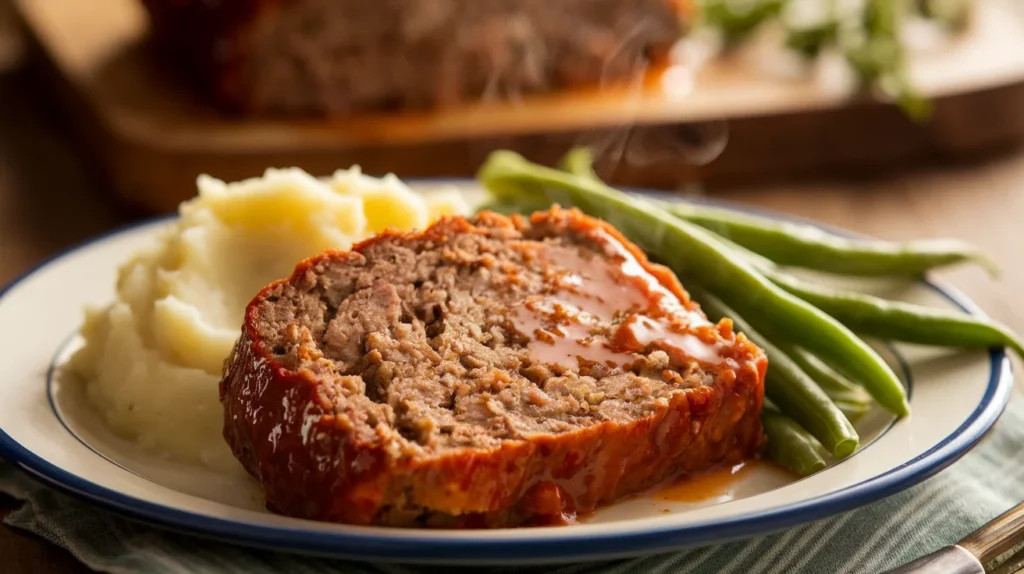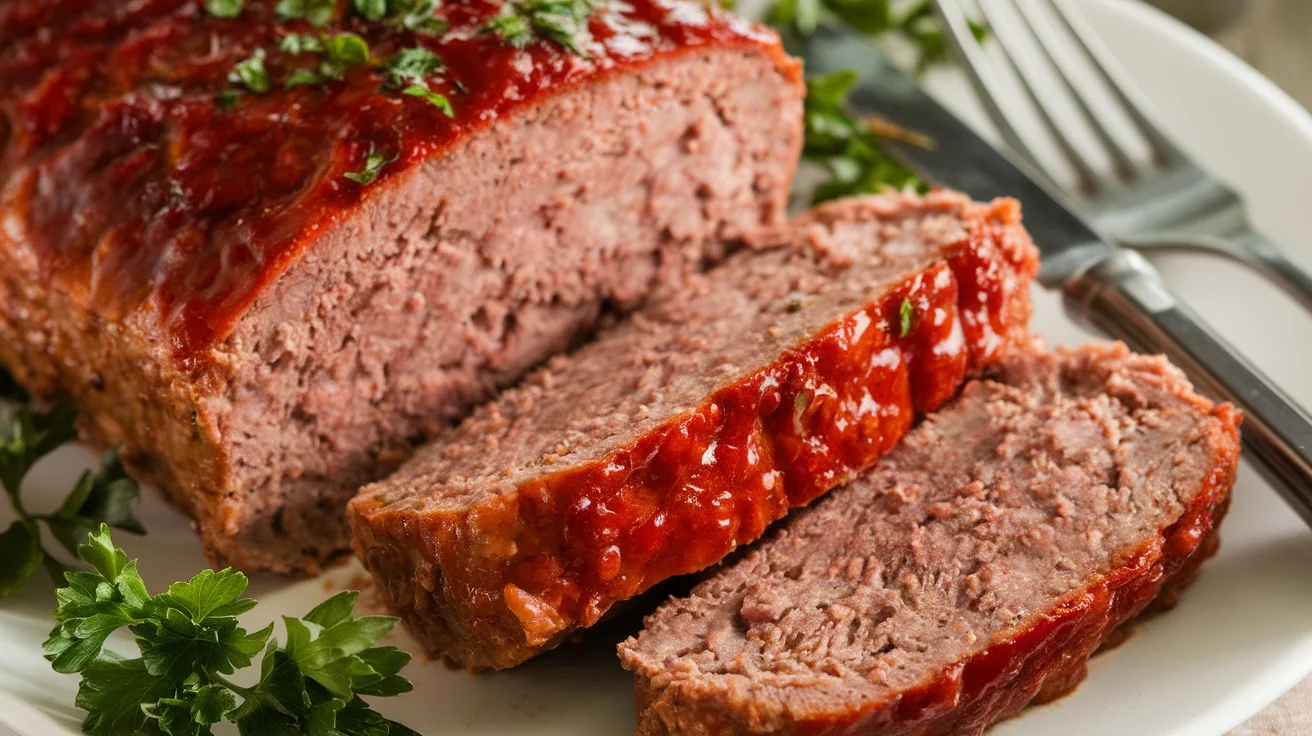Introduction
When it comes to making the perfect meatloaf, small decisions can make a big difference. One such question often arises: Why use milk instead of water in meatloaf? While water seems like a simple option, milk brings unique qualities to the recipe that elevate this classic dish to a new level.
In this article, we’ll explore the science and taste behind using milk in meatloaf, uncover its benefits, and provide tips to help you achieve moist, flavorful results every time. Whether you’re a beginner or a seasoned home cook, understanding this choice will transform your meatloaf into a masterpiece.
What You’ll Learn in This Article
- The essential role of liquid in meatloaf recipes
- Why milk is preferred over water for moisture and flavor
- Alternative options if milk isn’t available
- Tips for crafting the perfect meatloaf
Let’s start by understanding the foundation of meatloaf and the importance of liquid ingredients in creating a dish that’s both tender and delicious.
Understanding Meatloaf Basics
Meatloaf has been a staple in homes for decades, loved for its hearty and satisfying nature. Its versatility allows it to be adapted to various tastes and dietary needs, but the foundation of a great meatloaf lies in a classic recipe that balances meat, binders, and liquid ingredients.
At its core, meatloaf is a combination of ground meat (commonly beef, pork, or turkey), breadcrumbs, eggs, seasonings, and a liquid component. This liquid is critical in ensuring that the meatloaf is not dry and crumbly but instead moist and tender. While water may seem like an obvious choice, many recipes call for milk due to its unique properties that enhance the dish.
Before delving into the reasons behind using milk, it’s essential to understand the role liquids play in the chemistry of meatloaf. Liquids don’t just add moisture—they also affect texture, flavor, and even the structural integrity of the final product.
Why Milk Instead of Water in Meatloaf: The Role of Liquid
Adding liquid to meatloaf serves several purposes:
- Binding the Ingredients: Liquids help bind the breadcrumbs to the meat, ensuring the mixture holds together while baking.
- Moisture Retention: Liquids prevent the meat from drying out, which is especially crucial for lean cuts of meat.
- Improving Texture: The right liquid ensures the meatloaf stays soft and tender, making it enjoyable to eat.
While water may provide moisture, it doesn’t contribute to the flavor or richness of the dish. This is where milk truly shines, offering both functional and flavor-enhancing benefits.
Why Milk Instead of Water in Meatloaf?
Milk is more than just a liquid—it’s a combination of water, fats, and proteins that bring unique qualities to meatloaf. Here’s why milk is often preferred over water:
- Enhanced Flavor: The natural sugars and proteins in milk subtly enhance the flavor profile of meatloaf, adding a mild creaminess that water cannot provide.
- Improved Moisture: Milk’s fat content helps retain moisture in the meatloaf, ensuring it stays juicy throughout the cooking process.
- Binder Activation: Milk soaks into breadcrumbs more effectively than water, creating a paste-like consistency that binds the mixture better.
- Textural Benefits: The proteins in milk contribute to a finer, more cohesive texture in the finished product.
By using milk, you’re not only preventing dryness but also infusing the meatloaf with a richness that makes every bite satisfying. In the next section, we’ll explore how milk specifically impacts the texture and moisture of meatloaf in greater detail.
Understanding Meatloaf Basics
Meatloaf has been a staple in homes for decades, loved for its hearty and satisfying nature. Its versatility allows it to be adapted to various tastes and dietary needs, but the foundation of a great meatloaf lies in a classic recipe that balances meat, binders, and liquid ingredients.
At its core, meatloaf is a combination of ground meat (commonly beef, pork, or turkey), breadcrumbs, eggs, seasonings, and a liquid component. This liquid is critical in ensuring that the meatloaf is not dry and crumbly but instead moist and tender. While water may seem like an obvious choice, many recipes call for milk due to its unique properties that enhance the dish.
Before delving into the reasons behind using milk, it’s essential to understand the role liquids play in the chemistry of meatloaf. Liquids don’t just add moisture—they also affect texture, flavor, and even the structural integrity of the final product.
The Role of Liquid in Meatloaf

Adding liquid to meatloaf serves several purposes:
- Binding the Ingredients: Liquids help bind the breadcrumbs to the meat, ensuring the mixture holds together while baking.
- Moisture Retention: Liquids prevent the meat from drying out, which is especially crucial for lean cuts of meat.
- Improving Texture: The right liquid ensures the meatloaf stays soft and tender, making it enjoyable to eat.
While water may provide moisture, it doesn’t contribute to the flavor or richness of the dish. This is where milk truly shines, offering both functional and flavor-enhancing benefits.
Why Milk Instead of Water in Meatloaf?
Milk is more than just a liquid—it’s a combination of water, fats, and proteins that bring unique qualities to meatloaf. Here’s why milk is often preferred over water:
- Enhanced Flavor: The natural sugars and proteins in milk subtly enhance the flavor profile of meatloaf, adding a mild creaminess that water cannot provide.
- Improved Moisture: Milk’s fat content helps retain moisture in the meatloaf, ensuring it stays juicy throughout the cooking process.
- Binder Activation: Milk soaks into breadcrumbs more effectively than water, creating a paste-like consistency that binds the mixture better.
- Textural Benefits: The proteins in milk contribute to a finer, more cohesive texture in the finished product.
By using milk, you’re not only preventing dryness but also infusing the meatloaf with a richness that makes every bite satisfying. In the next section, we’ll explore how milk specifically impacts the texture and moisture of meatloaf in greater detail.
The Role of Liquid in Meatloaf
Liquids are a key component of any great meatloaf recipe, serving multiple purposes that go beyond simply keeping the dish moist. Without the right amount and type of liquid, your meatloaf could turn out dry, crumbly, or lacking in flavor. Understanding the science behind liquid ingredients will help you achieve a meatloaf that is both tender and flavorful.
Binding the Ingredients
One of the primary functions of liquid in meatloaf is to bind the ingredients together. Liquids interact with breadcrumbs, oats, or other fillers in the recipe, creating a soft and cohesive mixture. This process ensures that the meatloaf holds its shape during cooking and slicing, while also preventing it from falling apart.
Milk, in particular, excels in this role because it soaks into breadcrumbs more effectively than water, forming a rich, paste-like binder that blends seamlessly with the ground meat. This binding action is critical for achieving the smooth and uniform texture meatloaf is known for.
Moisture Retention
Another essential function of liquid is moisture retention. Meatloaf, especially when made with lean meats like turkey or chicken, can dry out during the cooking process. Liquids help counteract this by hydrating the mixture and locking in moisture as it bakes.
Milk not only provides moisture but also contributes fats and proteins, which help retain juiciness throughout the cooking process. These elements work together to ensure every bite is tender and satisfying.
Improving Texture
Texture is a crucial aspect of a well-made meatloaf. No one wants a dense or rubbery dish, and the right liquid can make all the difference. By hydrating the breadcrumbs, liquids help create a soft and airy texture in the final product. Milk’s fats and proteins play an additional role, creating a creamy and delicate consistency that water alone cannot achieve.
Using the proper amount of liquid is key. Too little can lead to a dry meatloaf, while too much can make it mushy and prone to falling apart. This balance is easier to achieve when using milk, as its thicker consistency naturally helps control the moisture level in the mixture.
Enhancing Flavor
Finally, liquids add an extra layer of flavor to meatloaf. While water is neutral and adds no taste, milk contributes a mild creaminess and subtle sweetness. These qualities enhance the overall flavor profile of the meatloaf, making it richer and more enjoyable.
In the next section, we’ll take a closer look at why milk is often chosen over water and how its unique properties elevate the dish in terms of both flavor and texture.
Why Milk Instead of Water in Meatloaf?
The choice between milk and water in meatloaf might seem minor, but it has a significant impact on the dish’s quality. Milk isn’t just a liquid—it’s a combination of water, fats, proteins, and natural sugars that interact with the other ingredients to enhance the texture, flavor, and overall experience of meatloaf. Let’s break down the specific reasons why milk is the preferred option.
Milk’s Unique Properties
Milk brings a variety of beneficial properties to a meatloaf recipe:
- Richness: The fats in milk add richness to the meatloaf, making it taste more indulgent.
- Binding Strength: Milk is absorbed by breadcrumbs more effectively than water, creating a thick, paste-like binder that holds the meat mixture together.
- Mild Sweetness: The natural lactose in milk imparts a subtle sweetness, enhancing the flavor profile of the meatloaf without overpowering it.
Water, by contrast, lacks fats, proteins, and sugars, so it only adds moisture without contributing to the dish’s richness or flavor.
Improved Moisture Retention
Milk helps to lock in moisture better than water, thanks to its fats and proteins. These components coat the meat and breadcrumbs, forming a barrier that prevents the meatloaf from drying out during the baking process. The result is a juicier, more succulent meatloaf that maintains its moisture even when reheated.
Enhanced Flavor
One of the biggest advantages of milk is the subtle boost in flavor it provides. The creaminess and natural sugars in milk complement the savory flavors of the meat, seasonings, and other ingredients. Water, being flavorless, doesn’t offer this benefit. By using milk, you’re adding depth to the dish, making it more satisfying and well-rounded.
Better Texture
Milk also plays a key role in achieving the ideal meatloaf texture. The proteins in milk interact with the meat and binders, creating a smoother and more cohesive mixture. This helps produce a tender, yet firm, meatloaf that holds its shape while slicing but melts in your mouth with every bite.
A Nutritional Edge
Milk brings nutritional benefits to the table as well. It’s a good source of calcium, vitamins, and proteins that aren’t present in water. While these nutrients don’t dramatically alter the dish’s overall nutritional profile, they do add a slight edge, especially for those looking to make their meals more wholesome.
In the following sections, we’ll discuss how milk influences moisture and texture in detail and explore some alternatives for those who prefer not to use dairy in their meatloaf recipes.
Milk vs Water in Meatloaf: How It Transforms Moisture and Texture

One of the standout benefits of using milk in meatloaf is the way it dramatically improves both moisture and texture. These two elements are crucial to creating a dish that is enjoyable to eat, and milk’s unique composition makes it the ideal choice for achieving the perfect balance. Let’s delve deeper into how milk influences these aspects.
Achieving Superior Moisture
Dry meatloaf is a common problem, especially when leaner meats like ground turkey or chicken are used. Milk combats this issue by adding much-needed fats and proteins to the mixture. Unlike water, which evaporates quickly during cooking, milk’s fats coat the breadcrumbs and meat, locking in moisture throughout the baking process.
The result is a meatloaf that remains juicy and flavorful, even after extended cooking times. This moisture retention is especially important if you plan to store leftovers, as milk-based meatloaf reheats more effectively without becoming tough or dry.
Smoothing the Texture
Texture is just as important as flavor when it comes to meatloaf. Milk plays a pivotal role in creating a soft, tender consistency that makes every bite a delight. Its proteins interact with the breadcrumbs and eggs, forming a cohesive mixture that ensures the meatloaf holds together during cooking without becoming too dense or crumbly.
Milk-soaked breadcrumbs are particularly effective at breaking down tougher proteins in the ground meat, resulting in a smoother final product. This process, known as tenderization, is key to avoiding the rubbery texture that can sometimes occur with water-based recipes.
Preventing Over-Mixing
Over-mixing is a common pitfall when preparing meatloaf. It can lead to a tough texture as proteins in the meat become overworked. Milk helps mitigate this by providing a lubricating effect that makes the ingredients easier to combine without excessive handling. This not only saves you effort but also ensures your meatloaf remains tender and light.
Ensuring Consistency
Milk contributes to the overall consistency of the meatloaf mixture, helping it achieve the perfect balance between firm and soft. This consistency ensures that the meatloaf slices cleanly and holds its shape, making it easier to serve and enjoy.
By now, it’s clear that milk is an indispensable ingredient for crafting a moist and tender meatloaf. In the next section, we’ll discuss how milk subtly enhances the flavor profile of the dish and why it’s preferred over other liquid options.
FAQs About Using Milk in Meatloaf

Here are some of the most frequently asked questions about using milk in meatloaf and their answers to help you perfect your recipe:
1. Can I use water instead of milk in meatloaf?
Yes, you can use water as a substitute for milk, but it may affect the texture and flavor of the dish. Water lacks the fats and proteins that milk provides, which means the meatloaf may turn out less moist and flavorful. Consider adding a bit of melted butter to water for a closer substitute.
2. What can I use if I’m lactose intolerant?
If you’re lactose intolerant or prefer a non-dairy option, you can use alternatives like unsweetened almond milk, oat milk, or soy milk. These substitutes mimic the texture and binding properties of regular milk without the dairy content. Be sure to choose unsweetened and unflavored varieties for best results.
3. How much milk should I use in a meatloaf recipe?
Typically, most recipes call for about 1/3 to 1/2 cup of milk per pound of ground meat. This amount is sufficient to hydrate the breadcrumbs and bind the mixture without making it too wet. Adjust based on the specific recipe or the moisture content of your other ingredients.
4. Does milk affect the cooking time of meatloaf?
No, milk does not significantly affect the cooking time of meatloaf. However, it ensures that the meatloaf stays moist throughout the baking process, even if slightly overcooked. Be sure to use a meat thermometer to check for doneness, aiming for an internal temperature of 160°F (71°C).
5. Why do some recipes call for milk while others don’t?
Some recipes use alternative liquids like broth, tomato juice, or cream instead of milk. These options can work well but may change the flavor and texture of the dish. Milk remains a popular choice because it strikes the perfect balance between moisture, richness, and subtle flavor enhancement.
6. Can I add other liquids along with milk?
Yes, you can mix milk with other liquids like Worcestershire sauce, ketchup, or beef broth for additional flavor. Just be cautious not to add too much liquid, as this can make the meatloaf overly soft and difficult to slice.
Conclusion: The Case for Milk in Meatloaf
Using milk instead of water in meatloaf isn’t just a minor tweak—it’s a game-changer. Milk’s unique combination of fats, proteins, and natural sugars elevates the dish by improving its moisture, texture, and flavor. Whether you’re making a traditional meatloaf or experimenting with variations, milk helps ensure a result that’s tender, juicy, and bursting with flavor.
While there are alternatives to milk for those with dietary restrictions, its unmatched qualities make it the go-to choice for most recipes. By understanding its role and benefits, you can take your meatloaf from ordinary to extraordinary, delighting your family and guests with every bite.
So next time you’re preparing meatloaf, don’t just reach for water—reach for milk and experience the difference it makes!

